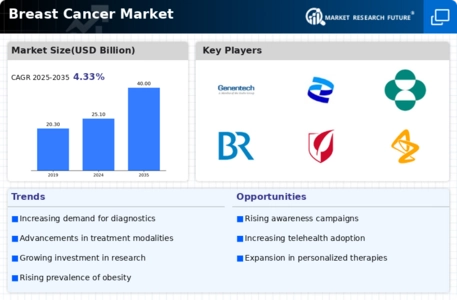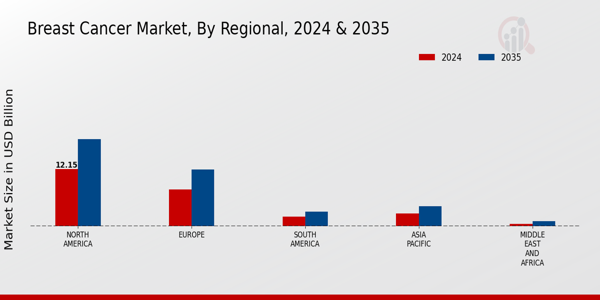Market Trends
Introduction
The breast cancer market is experiencing a major change as we enter the year 2024, driven by a number of macro-economic factors. The technological developments in the field of precision medicine and immunotherapy are reshaping the treatment models, enabling more effective and individualised therapies. At the same time, the regulatory pressures are increasing, and the regulatory authorities are pushing for faster approval of new therapies, thus accelerating the introduction of new treatments. The consumers’ behaviour, with the increased awareness of and advocacy for early detection and treatment, also has an effect on the demand. These trends are strategically important for the companies as they not only highlight the changing landscape of breast cancer treatment, but also highlight the need for adaptation strategies to stay in a rapidly changing market.
Top Trends
-
Personalized Medicine Advancements
The shift towards a more individualized medicine is transforming the treatment of breast cancer. Earlier, chemoradiation was the main treatment, but now the trend is towards targeted therapy. In 2023, for example, the Food and Drug Administration approved several new targeted therapies, which have led to improved survival. According to research, a targeted therapy can increase survival by as much as 30 per cent. The trend is leading the pharmaceutical industry to increase its investment in biomarker research, which in turn is strengthening their product portfolios and market position. -
Increased Focus on Early Detection
Governments and health organisations are promoting early detection of breast cancer through initiatives such as National Breast Cancer Awareness Month. Early detection can reduce the risk of death by up to a quarter. The development of advanced screening technology and AI-driven diagnostic tools is expected to improve the screening efficiency and accuracy and consequently the market opportunities. -
Integration of Digital Health Solutions
INTEGRATION OF DIGITAL HEALTH SOLUTIONS, i.e. telemedicine and mobile applications, is transforming patient management in breast cancer. A survey revealed that seventy per cent of patients prefer telehealth consultations. Consequently, the companies are developing digital platforms to facilitate remote monitoring and support, to improve patient engagement and adherence to treatment. -
Emergence of Immunotherapy
Immunotherapy is being considered as a possible treatment for breast cancer. A number of clinical trials have been carried out with encouraging results. In particular, recent studies have shown that the response rate to the treatment of triple-negative breast cancer is improved by 40 per cent by immunotherapy. This is encouraging pharmaceutical companies to invest in research and development, which could lead to new products and market growth. -
Regulatory Support for Innovative Therapies
The approval of the regulating authorities has tended to be more and more favorable towards innovation. The breakthrough therapy status of the FDA has accelerated the approval of several new treatments for breast cancer. In this regulatory environment, there is a new wave of R & D from the major players, which may lead to a wider range of treatments on the market. -
Focus on Patient-Centric Care
The patient-centered care model is becoming increasingly popular, and patient preferences and experiences are given priority. Patients’ satisfaction with their care is associated with better adherence to treatment and outcomes. Product development is being adapted to include patient input, which may lead to greater patient loyalty and market share. -
Collaborative Research Initiatives
It is increasingly common for universities and industry to work together on research, which is driving the development of new therapies for breast cancer. For example, it is such collaborations that have made it possible to develop combinations of drugs that are more effective. This trend is creating a culture of sharing knowledge and resources, which can speed up the development of new treatments and make them more competitive. -
Sustainability in Drug Development
In recent years, the development of new drugs has been accompanied by an increased interest in the environment, with companies adopting sustainable practices. According to a survey, some 60 per cent of pharmaceutical companies are investing in sustainable practices. This trend not only increases the companies’ CSR profile but also makes them more attractive to consumers who are concerned about the environment, which could influence their buying decisions. -
Global Market Expansion
The breast cancer market is growing significantly in emerging economies, driven by increasing awareness and access to health care. The number of women affected by breast cancer is rising in regions such as Asia and Africa. Strategically entering these markets could lead to increased competition and the introduction of affordable treatment options that are more suited to local needs. -
Advancements in Genetic Testing
And now, in the era of genetics, the assessment of breast cancer risk is revolutionized. Genes can be used to identify high-risk individuals and to take preventive measures to reduce the risk of cancer. This is leading to a comprehensive genetic test, which will benefit patients and create new business opportunities.
Conclusion: Navigating the Competitive Breast Cancer Landscape
The breast cancer market in 2024 is characterised by high competition and a large number of participants, with both established and new entrants competing for market share. Regional trends indicate a growing focus on personalised medicine and new treatment modalities, especially in North America and Europe where regulatory environments are increasingly supportive of new therapies. The strategic positioning of vendors is increasingly reliant on advanced capabilities such as artificial intelligence for predictive analytics, automation for operational efficiency and sustainable practices to meet evolving patient expectations. The ability to respond quickly to new trends and the needs of patients will be the most important differentiating factors for market leaders.

















Leave a Comment